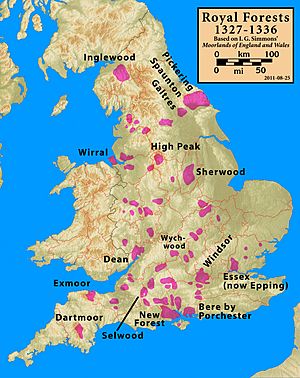Inglewood Forest facts for kids
Inglewood Forest is a large area of land in Cumbria, England. It's mostly made up of farms, with some smaller wooded areas. This historic region is located between the cities of Carlisle and Penrith, Cumbria. Even though it's called a "forest," today it's mainly farmland.
Contents
What's in a Name?
The name Inglewood is very old. It first appeared around the year 1150. It means "Wood of the English" or "Wood of the Angles." This name tells us something important about the past. At the time, much of Cumbria was still a place where people spoke a Celtic language called Cumbric. English settlers or landowners were not as common. So, calling it the "Wood of the English" helped to show that this area was different. It was a special place where English people lived or owned land, especially near the border between English and Celtic cultures.
A Royal Hunting Ground
Soon after the Norman conquest of England in 1066, Inglewood became a Royal Forest. This didn't mean it was all trees! A "forest" in this old sense was a special area set aside for the King or Queen to hunt. Even so, parts of Inglewood were indeed heavily wooded. The main animals hunted here were deer and wild boars.
The boundaries of the Royal Forest changed many times over the years. At one point, it covered a large part of what was then Cumberland. However, the main part of the forest was around the parishes of Hesket-in-the-Forest, Skelton and Hutton-in-the-Forest. Historians say the heart of the forest was between the Chalk Beck and the River Petteril. This included places like Dalston, Sebergham, Mungrisdale, Catterlen, Hutton, Skelton, and Castle Sowerby.
The English Crown owned the forest, and it was managed by very strict rules called Forest Law. These laws protected the animals and the hunting grounds. But during the time of Henry VIII, these special forest laws were removed. Inglewood stopped being a Royal Forest, even though maps still show it as one today.
The city of Carlisle was outside the forest's boundaries. However, Penrith was inside it. Penrith became an important market town and the main place for managing the southern part of the forest.
Defending the Borders
The area was also active with groups called Border reivers. These were families or clans who raided across the border between England and Scotland. To protect themselves, people in Inglewood Forest built many strong, fortified buildings. These were known as Peel towers. These towers were like small castles, designed to offer protection from raids.
Inglewood in Stories
Inglewood Forest is famous in old stories and poems. It's the setting for many adventures in medieval tales, especially those about knights and heroes.
Around the year 1420, a writer named Andrew of Wyntoun wrote a book called Orygynale Chronicle. In it, he claimed that Inglewood Forest was where the famous Robin Hood legend first began! He wrote:
- Lytil Jhon and Robyne Hude
- Wayth-men ware commendyd gude
- In Yngil-wode and Barnysdale
- Thai oysyd all this tyme thare trawale.
This old poem suggests that Robin Hood and Little John were active in Inglewood. According to legend, Inglewood Forest was also home to other famous outlaws: Adam Bell, William of Cloudsley, and Clym of the Clough. Their exciting story is told in an old folk song called "Child Ballad 116."
The Honour of Penrith
Several important areas, or manors, near Inglewood Forest were grouped together. These included Penrith, Great Salkeld, Langwathby, Carlatton, Castle Sowerby, and Scotby. Together, they were known as the Honour of Penrith.
These lands were first given to the Scottish Crown. This was part of a deal where Scotland gave up its claim to all of Cumberland. Later, King Edward I took these lands for himself. Over time, they passed to different powerful families, like the Neville family. But they eventually returned to being owned by the English Crown.
The Honour of Penrith was also sometimes called "The Queen's Hames." This was because the lands were often given to a Queen consort (the wife of a King) when she married or after the previous Queen died. The last Queen consort to own these lands was Catherine of Braganza, who was married to Charles II of England.
Later, King William III gave these lands to his friend, William Bentinck. His family eventually sold them to their relatives, the Cavendish family.
Images for kids





